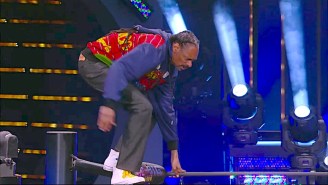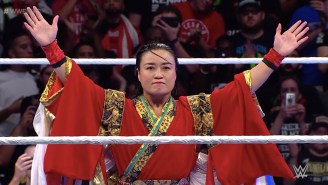Last week this column was derailed by a city-wide cable and internet outage, so if you were looking for it hey, you, sorry about that. Thanks for coming back. If this is your first exposure to the feature, be sure to check out the very first post about Alundra Blayze and Bull Nakano’s baller SummerSlam match from 1994.
This week’s feature is inspired by a match that sees its nineteenth anniversary this week. In searching for more in-depth information, instead of finding the wealth of documentation and video you expect from 1990s wrestling, I found multiple contradictions, a severe lack of reliable sources, and a near erasure of the influences and innovations of women’s wrestling. What I hope you’ll discover, however, is the indomitable fighting spirit of some of the toughest, most brutal, most creative wrestlers there are: the ladies of the FMW joshi deathmatch.
A Brief History of Garbage Wrestling
Additionally, just who is it that ENJOYS this sideshow garbage? The same type of people who go to rock concerts to punch and bash each other in the face and beat each other up in the “mosh pit”–lower class, mentally challenged college-age (but not attending) guys who piss and moan about their depression and lot in life because they have neither the drive and determination nor mental acumen to change it. Any normal fans who see this type of show or attend one with these type of fans NEVER want to go to wrestling again. As bad as I hate sports entertainment, even THAT is certainly preferable to “hardcore” wrestling. – Jim Cornette
The origins of the deathmatch, like anything that is reliant upon oral histories, is debatable. Some, like Jim Cornette, will argue that its roots are firmly planted in deep south wrestling. Others will credit it to the use of foreign objects in Puerto Rico, or “pier six brawls” in Chicago from wrestlers like Crusher and Bruiser in the 1970s. Brass knuckles were used in the National Wrestling Alliance in Texas and Florida as early as the 1950s. Across the decades you can find numerous accounts of promoters whatever could do to “get some colour,” and enhance the notion that what the audience was watching was not predetermined or choreographed, but rather a real-life fight. By the late 1980s, wrestlers like Abdullah the Butcher and Terry Funk were upping the ante in the hardcore style.
Wrestling history, like anything else, is written by the victor. Oral histories are the easiest to spin and embellish over time. Like the “shoot interview,” these stories can be just as false or “worked” as any match. Wrestlers with grudges can rewrite events to paint another in an unflattering light, or outright lie about any given situation. You can see more than enough examples of its mutability in the continual retconning of the Monday Night Wars between WWE and WCW. But WWE won, they remain the insurmountable titan, and can tell any story they see fit.
The most common and consistent catalyst in the evolution from a simple no-holds barred match to what we widely accept as the modern day version of the deathmatch is the founding of Frontier Martial-Arts Wrestling. Created by Atsushi Onita in 1989, the company was a key proponent in the popularization of extremes: barbed wire, tables, fires, land mines, and exploding ring matches to name a few. Giant Baba, owner of the rival All-Japan Pro Wrestling, referred to it as “Garbage Wrestling.” This was accepted as a broad term for wrestling that involved those with little talent, but a high tolerance for pain and a willingness to participate in dangerous stunts and routinely risk great personal injury. The ultraviolent “garbage” style would help inspire the very heart and soul of ECW, and its influences are still felt in more current promotions like BJW and CZW.
The Search Begins
“I haven’t liked any women matches in PWG ever.” “Flights are too expensive, and I’d probably never fly anyone in for a women’s match.” – Super Dragon in 2012, when asked if more women would be showing up in Pro Wrestling Guerrilla
When you start to research garbage wrestling, there are a number of sources who will direct you to this Terry Funk match, or that WING Kanemura match. There are lists upon lists of what to do and where to start and rankings and re-rankings of the supposed very best, but the attention paid to the female part of FMW is lacking. Initially I had the want to write about the Tag Team Barbed Wire Deathmatch between Combat Toyoda and Megumi Kudo against Bad Nurse Nakamura, Miwa Sato, and Shark Tsuchiya from FMW Grand Slam 1995 since it took place nineteen years ago this week. I had read a few different blurbs citing this as the first women’s barbed wire match, but it didn’t add up. Four of those ladies had already participated in a barbed wire match a week prior. Not to mention that there is no video of it up to link to, making it hard to watch and subsequently write about. That seems like the kind of thing we could note and get straight since it happened in the past two decades, no?
You’ll also find that when searching for the first for real barbed wire ladies’ match, Combat Toyada’s 1996 retirement match comes up a lot. We’ve already established at least two in 1995, so why the claim otherwise? Why is it so hard to keep track of the first one? We laud Edge and Christian and the Dudleys and Hardys for the TLC match, and that was a scant five years later, so why not something as momentous as that in women’s wrestling history?
One of the best things about my job here at With Spandex is that I get to fulfill my desire, nay need to watch all of the wrestling. It’s an immense amount of fun to introduce people to something near and dear to my heart – like when I get to write about Chikara – but it’s a joy to be able to explore the world of wrestling, and learn about things right along with you. Filling in gaps in my wrestling knowledge, and falling in love with new wrestlers and matches along the way. I was already familiar with Megumi Kudo, but why not learn more? Why not show people who maybe aren’t as familiar with her as much as I possibly could? But then…more problems. More discrepancies.
The Kudome Valentine, known to some as the Kudo Driver, the Vertebreaker, or the Cop/Gringo Killa, was innovated by Megumi Kudo. Technically it’s a back-to-back double-underhook piledriver, and…well, I’ll just show you:
Every time Homicide does it I cringe a little, not just because that’s kind of my general reaction to Homicide, but because it looks nasty for all the wrong reasons. When Kudo does it, I cringe because it looks nasty as f-ck for all of the right reasons. It’s exciting and dangerous, but there’s a fluidity to the way that she moves that’s beautiful, really. But when you see the move, unless you’re talking to established puro/joshi fans, it’s usually called something else. The originator is removed from the equation. I mean, the Wikipedia listing doesn’t even mention her by name.
This happens more than you may think. The Burning Hammer, most commonly attributed to Kenta Kobashi, was invented by Kyoko Inoue. The Tiger Driver ’91 and Jackhammer were innovated by Jaguar Yokota. The Moonsault Double Stomp was created by Hikari Fukuoka. The Air Raid Crash? Mariko Yoshida. The Gutwrench Powerbomb? Yup, another joshi (and an incredible one at that) – Akira Hokuto. It took three days of waiting for a response in a joshi Facebook group before someone could point me to an English record of the first Kudome Valentine used as a finish, but it’s not noted whether or not it actually was the first time used in a match. It seems like that would be something worth knowing, right?
As I thought about it more and more, and with the original match I wanted to write about seemingly impossible to find online, I got more and more frustrated. At this point it goes far beyond a matter of simply putting in the time to do your research. Why should it take that much digging through conflicting or downright false declarations with zero citations? As my friend Bill put it, “I can go find the exact date and result of every Corporal Kirschner match ever; we should be able to find out for certain when the first women’s barbed wire match happened.”
But that’s the heart of it right there, isn’t it? If over time we are separating these women from their accomplishments and willfully accepting the attribution of their innovations to other people, it becomes easier and easier to erase them from the conversation entirely. With all that ECW brought over from Japan, women with their own agency and talent that rivaled many male wrestlers were eschewed in favour of tits and ass and thongs and catfights. Even someone like Jazz was barely more than a valet.
The obvious answer to many of these questions is that women are still not viewed on the same physical or intellectual level as their peers. If you are constantly presented with the idea that women are weak, easily emotionally compromised, subservient sexual props, then it’s easy to nod your head and agree when people make brash statements with no evidence to back it up. When former WWE creative member and current Ring of Honor consultant Court Bauer boldly declared on his radio show that in order to save money, the WWE should eliminate the Divas division because they don’t draw or sell merch, how many people do you think went “yeah, that guy knows what up,” without ever considering that this was prefaced by his admission that he had no numbers or inside knowledge to back his statement? If it’s that easy to believe that someone who doesn’t work for WWE has their budget problems all figured out, or for someone who has worked in the business for that long to be that comfortable with removing women’s wrestling from the largest audience possible, it’s not a stretch to think that the archival efforts of what is considered by most North American fans to be a niche fandom – and still just a subset to puroresu as whole – could be left in such a disarray.
After all of that, I decided that I really wanted bring some of those ladies back into the conversation. While this may not have happened this week years ago, and was not the first ladies’ barbed wire match, it was the first electrified explosive barbed wire match, a retirement match, and a match so good and so brutal that it brought FMW founder Onita to tears.
May 5th, 1996: No-Rope Exploding Barbed Wire Deathmatch: Megumi Kudo vs. Combat Toyoda FMW
It’s just me and Toyoda, and we want to fight a match that leaves us both with no regrets. – Megumi Kudo
I’m nervous, but I have to give it my all. There have been a lot of ups and downs, but this fight between me and Kudo is very symbolic. So I want to go out strong. I can’t lose this one. – Combat Toyoda
On January 19th, 1986, over 500 girls came to audition for All Japan Women’s Pro-Wrestling. From that group, only eight would make it. Their names included Erika “Aja Kong” Shishido, Reibun Amada, Nobuko “Bison” Kimura, Noriyo “Combat” Toyoda, and Megumi Kudo. After months of training in the dojo, and after debuting against different women, best friends Kudo and Toyoda met for the first time in the ring on November 1st, 1986. They continued to work alongside each other in AJW until Kudo left in 1988. Toyoda and Reibun Amada would also leave within a year of Kudo’s departure.
Two years passed before Atsushi Onita would contact Amada, Toyoda, and Kudo to join his fledgling Frontier Martial-Arts Wrestling promotion. The trio were known as “The Outbreakers,” a veteran outsider heel stable there to declare war on the existing rookies of the FMW women’s division. Shortly thereafter, Onita decided that Kudo was too pretty to be a heel, and would function much better in the world of FMW as a babyface.
Over the next five years, Toyoda and Kudo would hold the FMW Women’s championship nine times, with five championships for Toyoda and four for Kudo. Toyoda would go into their match on May 5th defending the belt.
You don’t need to know the history these two share going into this match, but having a better understanding of what these two women accomplished side by side in life and in wrestling adds an emotional depth to an already emotional match. Kudo is fighting for to lead FMW into a new era. Toyoda wants to go out with respect, and honour Onita and FMW with her strength. Both Kudo and Toyoda, though far from being similar in appearance, also went through their careers judged on their looks. Both women had also put themselves through incredible feats, with barbed wire, fire, dog collars, and so much more, elevating them as titans of mid-nineties hardcore wrestling. When you step in the ring, it doesn’t matter who you are, who you’re friends with, or how you look. These, and the other women of FMW, would prove each and every time that wrestling can transcend all of those things.
While Kudo fought for the future, Toyoda fought for her legacy. She honoured the past of FMW before even stepping into the ring by entering to Atsushi Onita’s theme song, a Joan Jett cover of Wild Thing. From the get go, the emotional charge is palpable.
I love this match for a lot of reasons. There’s a really wonderful thing about truly great wrestling; you see it when you watch Dynamite Kid/Tiger Mask matches, or the rise of Misawa, Kawada, and Kobashi in Baba’s All-Japan. There are so many instances of needing to rely on commentary to help you through and have a better understanding of what it happening in the ring, and why it’s happening. When you don’t speak the language that commentary is in, it leaves the wrestling to speak for itself. In all of those cases, you don’t need to speak Japanese to understand the gravity and connection between the wrestlers.
The emotional strength is illustrated perfectly by the physical efforts on display. A lot of this match, one that requires a pin fall I might add, involves these showdowns and power moves. Every time the physically domineering Toyoda would push at Kudo, Kudo would push right back. Both had the fire and need to win for their own reasons, and though the two might look imbalanced physically, they were evenly matched the whole time.
There are these little moments both of them have that show the awareness and presence of each woman. You see it when Kudo is choking her from behind. Toyoda fights her natural instinct to reach for the ropes, grasping at the air in front of the barbed wire until she can eventually break the hold. At one point, Kudo dashes across the ring, stops short realizing she can’t launch herself off of ropes that aren’t there. She pauses, ever so briefly considering what to do, then launches herself full force into Toyoda and the electrified barbed wire, with no regard for her own well being. And that’s it right there. Both women are beating the tar out of one another, forcing each other into the ropes, bleeding all over the ring. They need to exhaust the other and wear each other down, because simply wrestling will not be enough to triumph over the will and spirit of the other. Every time someone goes into the barbed wire, it’s not senseless violence, it really means something.
The conclusion of the match carries just as much weight as the bout itself. Onita, already being moved to tears by these two putting their everything into a match, his match, rushes to the ring. He pours water over both of them, but while Kudo is taken out on a stretcher, he picks Toyoda up, puts her on his back, and carries her out of a match that solidly put both women at the heart and soul of the FMW legacy. Wild Thing, the theme they’ve now shared, plays over the speakers. They are one in the same. They are tough. They are fighters. They are wrestlers.
After the match, Toyoda would roll off of the table she had been set down on to meet Kudo on the floor. The two hugged and cried, a lifetime of wrestling between them coming to an end, but an enduring friendship that couldn’t be broken with weapons or barbed wire or blood and pain.
If the battleground for women proving their worth in the world of wrestling still has to exist, I am more than happy to have these these incredible fighters of immeasurable strength, passion, and skill in our arsenal.






